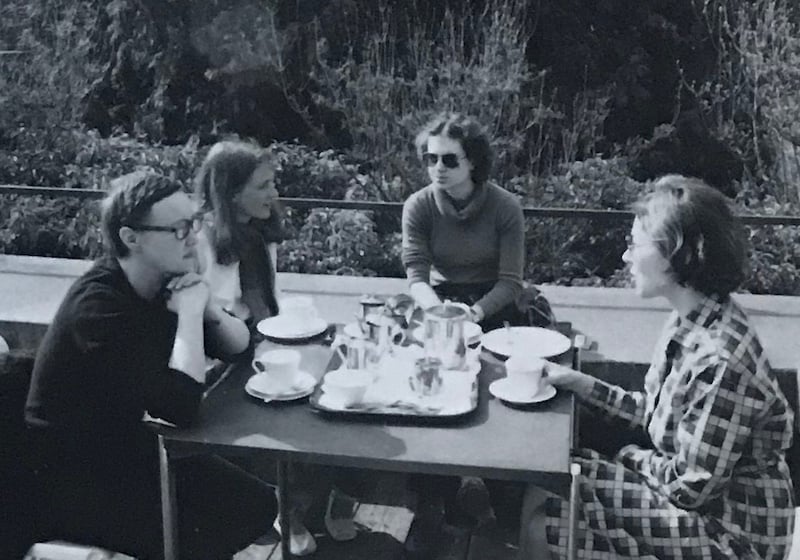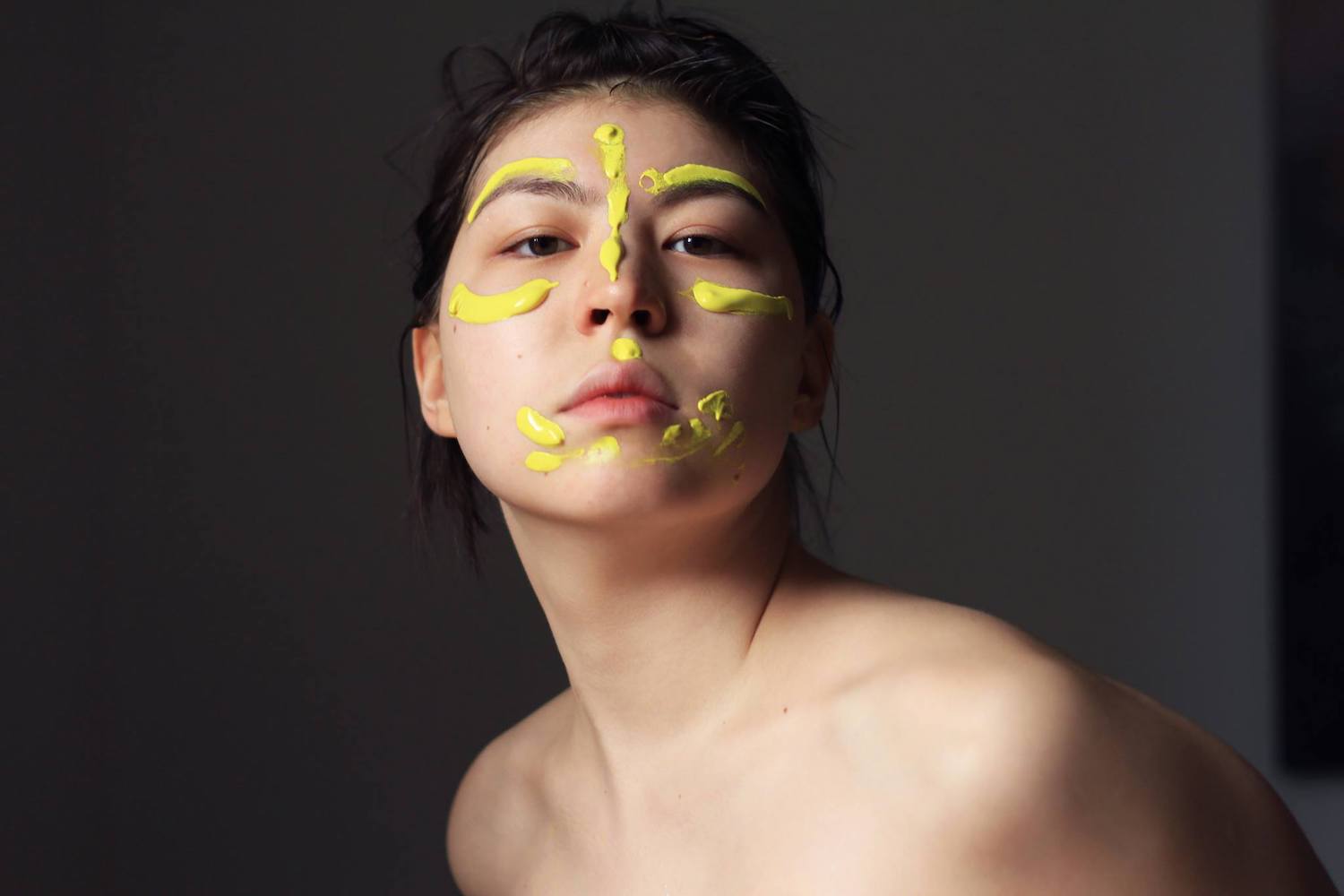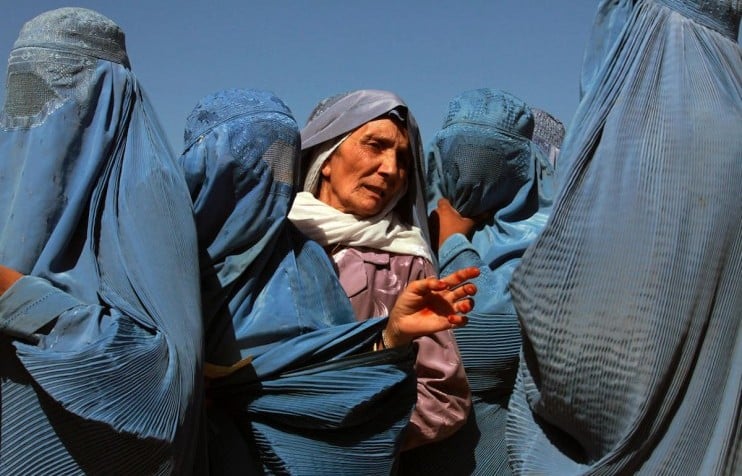The story behind the 70s samizdat that launched late Soviet feminism

Rejected both by dissidents and the authorities, the Soviet Union’s first feminist journal shone a light on domestic violence, unequal pay, and abuse in maternity hospitals — all while harnessing the same handmade zines beloved by Russian activists today.
In the late summer of 1979, two women in Leningrad sat down at their typewriters. They each typed five copies of a 131-page almanac called Woman and Russia, a new samizdat, or underground publication, that would become the first feminist journal in the Soviet Union. The articles, stories, and poetry inside described the ways women were oppressed by Soviet society on account of their gender.
With a circulation of only 10 copies, the hand-bound booklets were released into Leningrad in September. Readers would get their hands on a copy, devour the contents in one night, and pass it onto someone else.
News of the incendiary almanac and its woman editors reached the KGB by the end of the year.
News of the incendiary almanac and its woman editors reached the KGB by the end of the year. After months of intimidation, searches, and interrogation, the four main editors of Woman and Russia left the Soviet Union. Other editors and contributors remained behind, working anonymously to continue to publish and organise.
More than 40 years later, the exhibition Leningrad Feminism 1979 is traveling through Russia and beyond to share the story of Woman and Russia and the women behind it. The joint project by academics in Leipzig and St Petersburg began showing in St Petersburg in February. It planned to move to the Women’s Museum in Moscow in March but is delayed by the COVID-19 epidemic until at least August. From there, the exhibition will travel to Berlin, Leipzig, and other cities in Europe. I spoke with exhibition curator Olessja Bessmeltsewa of the Goethe-Institut in St Petersburg to learn more about the significance of this 10-copy magazine and how it brought women’s struggles in the Soviet Union to international attention.
Bessmeltsewa and co-curator Philipp Venghaus initially came up with the exhibition idea two years ago. They then set out on a trip across the world to track down the Woman and Russia team and record their stories.
“We started to search for these women in order to conduct video interviews with them. We wanted to understand how they were able to mobilise themselves, how they were able to even publish under those difficult conditions,” Bessmeltsewa recalls.
The copy of the first edition of Woman and Russia. Image courtesy of Leningrad Feminism in 1979
The early Soviet Union introduced some of the most progressive rights for women the world had ever seen. Decrees issued throughout the late 1910s and 20s made divorce quick and easy, guaranteed child support outside of legal unions, and allowed married couples to register in separate homes. It even became possible for newly married couples to both take the woman’s last name. Beyond legal code, Bolshevik culture upheld women as proud proletariats on the same level as men, and encouraged women to work in manual jobs and in the sciences.
These laws and practices were quickly disbanded under Stalin. Emphasis returned to the traditional nuclear family and the ideal Soviet woman became exemplified as a mother, wife, and communist. Although the post-Stalinist Soviet Union prided itself on its women’s successes, like Valentina Tereshkova, the first woman in space, and Yekaterina Furtseva, the first female secretary of the Communist Party since 1919, abuses against women continued behind communal apartment doors.
The sparks of the Soviet feminism reignited with a young student in Leningrad in the 1960s. Although Tatiana Mamonova was studying to become a pharmacist, she found herself more drawn to Western philosophy and sociology and spent hours an the library, scouring through books from France and the UK. She learned the word “feminism” for the first time and recognised the universal problems of inequality and repression of women in her own country. Mamonova went on to become an artist and poet, get married, and have a son. But in the 1970s, her belief in the need for feminism was reinforced by her degrading experiences in a maternity hospital and a sexual assault. At the end of the decade, Mamonova came up with the idea of a woman’s almanac. She began looking for women in Leningrad to contribute.
Tatiana Goricheva, Natalia Malakhovskaya, and Yuliya Vesnesenskaya did not know the word “feminism” until they met Mamonova. They were all three writers, religious believers, and Leningrad residents who had encountered mistreatment on account of their gender: Malakhovskaya endured an alcoholic husband and a lack of child support, Goricheva organised groups of religious women and was subsequently fired from multiple jobs, and Vesnesenskaya suffered in women’s labour camps throughout the 1960s and 70s. Mamonova discovered their writings on the woman’s experience and invited them to work on a new almanac.
“The other women may have had only a shaky theoretical basis [in feminism], but they were indignant at that which they experienced every day,” Bessmeltsewa says. “And this indignation was not only directed towards Soviet authority but also, to some extent, towards the relatively free and open world of underground publishing.”
Tatiana Mamonova tours Japan after leaving the USSR. Image courtesy of Leningrad Feminism in 1979 and Tatiana Mamonova
Illegal underground publications were nothing new in the Soviet Union. Samizdat was used heavily by dissidents, a group of intellectuals who campaigned for human rights in the late Soviet period. At first, it seemed that the feminists would fit in easily. They also fought for freedom of expression, and used art and literature. Some famous dissidents were women themselves. However, the feminists’ attempts to publish the almanac within dissident circles were swiftly dismissed.
“Tatiana Mamonova first wanted to produce the journal on a legal basis, but of course it was impossible to publish it officially,” Bessmeltsewa explains. “Then she started looking for connections with dissident women, but from these women it was clear why we had never been provided a voice. The question of women’s experience had never been posed in their circles. The dissident movement paid no attention to those topics.” Mamonova later wrote in the introduction to the English translation of Woman and Russia that “the dissident artists present themselves as nonconformists only in their art; in their attitude toward women, they are absolutely conformist.”
Mamonova later wrote in the introduction to the English translation of Woman and Russia that “the dissident artists present themselves as nonconformists only in their art; in their attitude toward women, they are absolutely conformist.”
The Woman and Russia collective set out to compile, print, and disseminate the almanac on their own. Throughout August 1979, they collected pieces by other woman contributors, edited the material, typed out 10 copies, and bound them. In September, just a month after beginning their work, they released the almanac into Leningrad.
The contents of the first issue of Woman and Russia describe the struggles women faced within the Soviet Union. The articles examine the double standard of women as proletariats, and as wives and mothers, humiliating conditions in birthing and abortion clinics, unequal pay, alcoholic and abusive husbands, poor quality childcare from the state, and more. There are letters from women’s labour camps, a history of women’s education in Russia, and poems and short stories. Altogether, their voices criticise the Soviet Union’s surface-level empowerment of woman, and its blind eye to abuse in the domestic sphere.
Translated editions of Woman and Russia and Woman and Earth. Image courtesy of Leningrad Feminism in 1979 and Tatiana Mamonova
Naturally, Woman and Russia soon came to the attention of the KGB. Mamonova was first interrogated by KGB officers in November 1979, and was warned in December that if a second issue were released, she would be arrested. The KGB searched contributors’ apartments, followed and intimidated them, and recruited neighbours to spy on them. Officers also began to confiscate copies of the journal.
The almanac may have been lost forever, had it not been for activists abroad. In fall 1979, before the confiscations began, a copy made its way to the French consulate in Leningrad and was smuggled into France. Feminists in the West were struck by the details of women’s plight on the other side of the Iron Curtain. Beginning in 1980, translations of the almanac appeared in feminist circles in France, Britain, Germany, Norway, Sweden, and Denmark.
“The picture presented in the journal showed that the reality was starkly different from the Soviet propaganda displayed in the West,” Bessmeltsewa explains. “The Soviet Union had always attempted to demonstrate that, although in truth rights were violated in the country, the people at least lived well.”
This was especially true of medical care, which many western leftists lauded as a free universal right in the Soviet Union, unlike in their own countries. Woman and Russia revealed that although healthcare was free, conditions in maternity hospitals and gynecological clinics were degrading.
As spring melted into summer, KGB threats against the editors and their families at home in Leningrad continued to mount. As the Moscow Olympic Games of 1980 loomed close, the main editorial team was given a choice: leave now or be arrested.
Voznesenskaya left for Vienna with her two sons in May 1980. The other three editors followed her in July, Mamonova with her husband and son, and Malakhovskaya with her son. The women claimed they were Jewish and emigrating to Israel, even though this wasn’t true, so that they could receive Israeli visas. After the first leg to Vienna, they could go anywhere.
The founders of Woman and Russia on the the cover of Ms. magazine. Image courtesy of Leningrad Feminism in 1979 and Tatiana Mamonova
Today, the women remain far flung throughout the world. Malakhovskaya settled in Austria. Goricheva spent time in West Germany and now lives in Paris. Mamonova left Paris for New York 20 years ago, where she now resides. Voznesenskaya worked for radio and wrote novels in Germany until she passed away in 2015.
The main editorial team split not only geographically but also ideologically. From the beginning the women were divided, especially on the question of religion. While Mamonova argued that the church was another form of patriarchy that brought Russian women down, the other women believed in a faith-based feminism, one that was loyal to Russian nationalism and the Orthodox church, similar to the spiritual dissidence of Alexander Solzhenitsyn. This discord within the group ultimately ended it. Before leaving the Soviet Union, Yuliya Voznesenskya and another Woman and Russia contributor, Sofia Sokolova, began work on a new journal, Mariya, that was more religious than feminist. Mamonova continued to serve as editor of Woman and Russia in future editions from abroad. After the dissolution of the Soviet Union, she renamed it Woman and Earth.
“Many of the principles [of the late Soviet movement] are very strange to modern ears. Especially that many of the women were Christians”
Bessmeltsewa explains that even in Russia, as well as in Europe, where the exhibition plans to tour, young feminists are most likely to be informed by American and European leftist literature. Visitors to the exhibition may find it difficult to grapple with the more conservative feminism for which many of the women advocated.
“Many of the principles [of the late Soviet movement] are very strange to modern ears. Especially that many of the women were Christians,” Bessmeltsewa acknowledges. With the exception of Mamonova, the cohort’s largely faith-based feminism disagreed with issues like abortion that are so key to most western feminist and current Russian feminists. Because of her own leftist ideas of feminism, Bessmeltsewa found it difficult to grapple with these more conservative ideas while developing the project.
“For me personally, it was important that every time I interviewed a new person or met a new concept, I reminded myself that because I am a leftist, this feminism does not appear like the feminism that I myself imagine or can understand. … But although feminist ideologies are so different, the main problems they’re concerned with have remained the same.”
A later edition of Woman and Russia magazine. Image courtesy of Leningrad Feminism in 1979 and Tatiana Mamonova
The 1970s and contemporary Russian feminist movements are tied by their use of the zine format, like samizdat, to spread the cause. The internet has allowed for greater education and mobilisation of feminism throughout the world, but many activists in Russia find it difficult to trust the internet with its state controls and surveillance. Handmade zines allow for more discreet and personal mobilisation within their communities.
“The original Woman and Russia almanac really does look similar to a modern zine, and that is very important,” Bessmeltsewa acknowledges. Modern zines are usually a mix of text and images, reproduced with a photocopier, or by hand. They might be handwritten or typed, created by one person or many, but the handmade nature and community circulation allows activists to quickly spread messages through their home region. The 1979 edition of Woman and Russia, too, combined typewritten texts by various contributors to speak directly to the women of Leningrad. Although the imagery of this Soviet zine doesn’t pop as much as many modern ones, the hand-drawn cover reflects the simple and replicable art that dons contemporary feminist zines: a pair of wings hovering over the universal symbol for women.
And, just as the zine format allowed the small Soviet feminist movement to take flight 40 years ago, Bessmeltsewa thinks the use of zines by today’s Russian feminists continues to garner hope for the movement. “The medium is very easy to produce, and this creates a lot of optimism for the feminist movement. People can look at it and comprehend it very quickly, and this helps and serves the same purpose as, say, feminist music groups. The general aim is to say we are here and these are our problems. It could not be more obvious that in Russia today there is still a need for society to recognise that these problems exist, and that they don’t only affect women, they affect everybody.”
The Leningrad Feminism in 1979 exhibition’s next stop in Moscow is currently delayed until August. Follow the Women’s Museum in Moscow Facebook page for further updates.


